Hey
folks!
Just a quick note on the past week's events regarding the Tsuga
Search
Project. Jess and I are in frantic wrap-up mode to get the
project finished
before he is off to grad school in early August. As of now, we
have three
trees left to climb, one of which will be a new volume record
for the
species. It also would have been a National Champion if HWA
didn't claim its
life. All trees remaining in the project are dead or well beyond
hope of
recovery.
July 5th found me and my mom going to climb the "Zahner
Pine" and measure it
for volume (she was along to assist and write a story about the
tree). This
HUGE eastern white pine growing in the Cullusaja Gorge near
Highlands, NC
has been on our big tree radar for over a decade, and Jess and I
felt it
justified to obtain the volume data to compare with eastern
hemlock and
other species we have modeled. Laser measurements put the tree
at 161.8 feet
tall and 13'10" in girth.
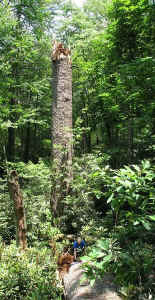
Zahner Pine lower trunk still standing |
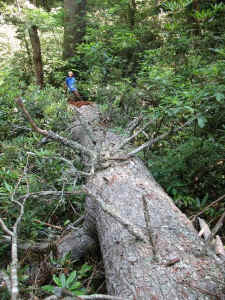
My mom in front of Zahner Pine with fallen section on ground |
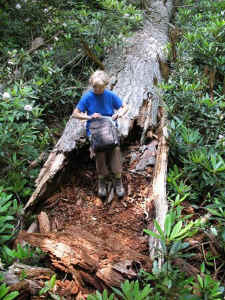
Breakage point at ~40’ |
All photos by Will Blozan, unless otherwise noted. |
The day was gorgeous- but the tree was down. We found the tree
snapped at 40
feet and the rest of the trunk straddled across a hideous grove
of
rhododendron. However, the dense rhododendron and a few logs
held the fallen
trunk up off the ground so obtaining the diameters was still
possible!
Furthermore, a piece of the tree still attached to the stub
could be matched
to the portion on the ground so the length of the tree could be
determined
and the diameters referenced to the ground for an accurate
modeling. In all,
123.9 feet of trunk were still intact and measured. The twin top
and two
huge reiterations were mere shrapnel. Pending further refinement
with a
reticle of the lower trunk the volume comes out to 1127 cubes of
trunk wood.
The trunk slowly tapered to 12'9" at 10.5 feet up and then
got slightly
larger (the reticle will be needed for this section) and was
still an
impressive 12'10" at 50 feet! This tree clearly claims the
title of the
largest known eastern white pine accurately measured. The next
largest ENTS
knows of is the "Cornplanter Pine" in NW Pennsylvania.
This tree, also dead,
has been reticled to just over 1000 ft3 of wood. The Zahner
Pine, when
standing and intact, was likely over 1170 cubes with the two
reiterations
and other top section included.
The next day, July 6th found Jess and me on the Tennessee side
of the
Smokies to do the climb/plot of the "LeConte Creek
Hemlock". This giant tree
had a girth of 18'9.5" and stood 140.4 feet tall.
Impressive as these
dimensions were, the tree only scaled 1190 cubes, falling shy of
the top 15
list by ~100 cubes. Unfortunately, the reticle over-estimated
the volume
likely due to catching wide portions of the trunk including bark
extrusions.
The advantage of the climb and tape wrap is it tends to average
the profile
of that section of trunk whereas the reticle "sees"
just the diameter and
any protuberances or ellipticality. This canopy emergence of
this tree gave
me an unwelcome but unique view of the Park Vista Hotel and
other blemishes
of Gatlinburg, TN. The next day we searched lower Surry Fork for
big
hemlocks but came up empty handed; nice trees but very short.
"LeConte
Creek Hemlock" |
 |

Jesse Webster and the LeConte Creek Hemlock |

Vista into Gatlinburg looking down LeConte Creek
|

Will tape wrapping lower trunk (taken by Jess Riddle) |

Park Vista Hotel and Space Needle |
We took Sunday to get ready for the next week's climbs in
Cataloochee.
Monday, July 9th found us back in NC in Cataloochee. Starting at
~2850 feet,
we hiked about 2 miles off trail and climbed to close to 4000
feet on the
east face of Shanty Mountain to climb the "Shanty Branch
Hemlock. Not a big
tree, this one was in our project due to the lasered height of
between 166.1
and 166.7 feet. This was also the highest elevation tree we have
in the
project. The top of this tree is close to 4200 feet above sea
level! I
finished the climb and modeling before the rain set in for a
bit. The tape
drop was 166.1' and the volume 912 ft3. It is very likely that
the hemlocks
Jess cored in this plot will exceed 400 years. Unfortunately,
like the
climbed tree, the grove is dead except for two decidedly green
trees. These
may warrant a revisit in a few years to check for resistance to
HWA. This
was the third tree I have climbed that gave me a view of the
fields of
Cataloochee Valley.
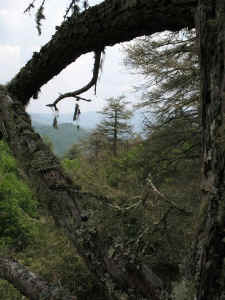 |
 |
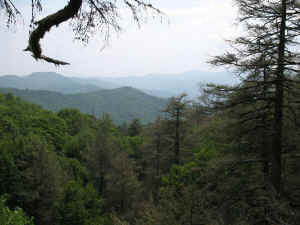
views from the Shanty Branch Hemlock looking east. |
Tuesday, July 10th we started on a three day trip up Caldwell
Fork in
Cataloochee to climb two trees, the "Double Gap
Hemlock" and the "Headless
Giant". We hiked the five mile trek up the Caldwell Fork
Trail, set up camp,
hiked up to the tree and completed the plot and climb of the
Double Gap tree
before dark. This tree was intended to be in the top 15 for
height but the
lasered height was 1.9 feet over the tape drop (~1% error is not
good
enough!). Still, at 164.8 feet this was no shorty! However, in
contrast to
other trees, the reticle underestimated this tree's volume. A
very welcome
surprise came when the climb data was analyzed. I knew this
multi-topped
tree would be big since at 100 feet it was 10'5" in girth-
a new girth
record for that height! However, Jess nor I expected the tree to
scale 1348
cubes! So it solidly landed itself a spot on the top 15 volume
list as the
seventh largest eastern hemlock. Sweet!!!

View down Double Gap Branch |

Three forks of the Double Gap Hemlock |

Looking up into the three forks |

Mossy elbow in Double Gap Hemlock
|
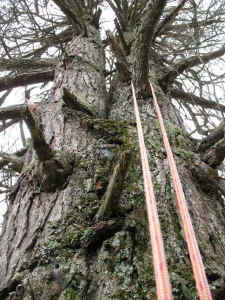
Up into the fusion |
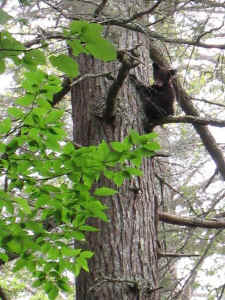
Climbing companion |
Wednesday July 11th (my 9th anniversary) we awoke to a steady
rain. When it
slacked off a bit our plans to complete the plot and climb of
the "Headless
Giant" were underway. We slogged up Caldwell Fork to the
mouth of Big Bald
Branch. The water was running a dark tannin color probably from
the hundreds
of acres of dead hemlocks upstream. Woodpeckers have been
pecking the outer
bark off in search of borers which may be resulting in a hemlock
bark tea. I
don't know what impact this has on the water critters.
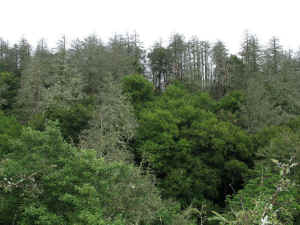
Service Ridge is DEAD… |

Black birch rooted in cavity at 102’ up |
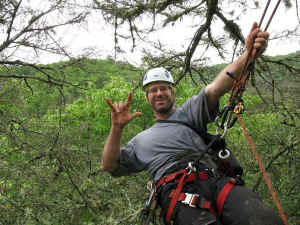
My anniversary photo for my sweetie! |

Highest reiteration and birch cavity |
Arrival at the tree brought on heavy showers and a thorough
soaking of all
vegetation and humans in the plot. We awaited the clearing sky
which
eventually appeared. Although short at 120.3 feet (laser and
taped height
were the same), this tree was the most strenuous hemlock climb I
have yet
completed. The wet tree and ropes added an unpleasant challenge.
It had
seven closely spaced reiterations and a tangle of other limbs
that made
canopy movement difficult. In hindsight I should have brought
the "motion
lanyard" used by Steve Sillett to traverse the complex
crown of this tree.
Regardless of the difficulty, I measured all seven reiterations
and the
remainder of the trunk (broken at 104') for a total volume of
1307 ft3. As
big as it is, this tree is among the smallest in the volume of
the top 15
(and the shortest).
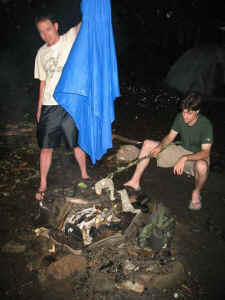
Drying out after the plot; Dan Bryson (NPS) and Jess Riddle roasting his socks. |
Arrival back at the campsite revealed a bear had taken one of my
socks (the
other still hanging lonely by itself), a t-shirt and bandana. It
later
returned for a pair of shorts to complete the outfit. The next
day we
explored a sort of hanging cove north of the campsite. It was
super wet,
full of seeps and nice, ancient hemlocks but none of superlative
stature.
And on the seventh day, we rested.
Will Blozan
President, Eastern Native Tree Society
President, Appalachian Arborists, Inc.
|